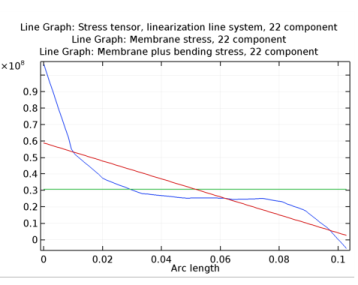|
•
|
In 3D, you must specify the x2 direction, and thus implicitly the x3 direction. You specify the orientation either by selecting a point in the x1-x2 plane, or by defining an orientation vector in an approximate x2 direction. In either case, the actual x2 direction is chosen so that it is perpendicular to the SCL, and lies in the plane you have specified. The x3 orientation is then taken as perpendicular to x1 and x2. As long as you are only interested in a stress intensity, the choice of orientation is arbitrary.
|
|
•
|
In 2D, the x3 direction is the out-of-plane direction, and the x2 direction is perpendicular to the SCL in the XY-plane.
|
|
•
|
In 2D axial symmetry, the x3 direction is the azimuthal direction, and the x2 direction is perpendicular to the SCL in the RZ-plane.
|
|
1
|
In the original component (assume that its tag is comp1), add a General Extrusion operator. Set Source frame to Material. You can name the operator, but in the following description, the default name genext1 is assumed. This operator will be used for mapping results to the second component.
|
|
2
|
|
3
|
|
6
|
Add a Prescribed Displacement node having domain selection. Select All domains. Prescribe the displacement in all directions to be the same as in the original model with expressions like comp1.genext1(u) for Prescribed in x direction.
|
|
7
|
If the original analysis contains inelastic strains, such as thermal expansions, these must also be included. You can do this either by adding a Thermal Expansion node with appropriate settings, or by explicitly importing the inelastic strains using an External Strain node. In the latter case, you would use expressions like comp1.genext1(solid.eth11) for the strain components.
|
|
8
|
Add Stress Linearization nodes for the new linearization lines.
|
|
9
|
Add the materials that were used in comp1. The most efficient approach is to add them under Global Definitions, and link to the same material definitions from both components.
|
|
10
|
Create a mesh for the domains in comp2 which you are solving for. It is only the mesh close to the new edges to which you need to pay any attention.
|
|
11
|
|
12
|
In the settings for the new study set Values of variables not solved for to point to the solution from which you want to pick the results in comp1. You can also add an Auxiliary sweep, if the original analysis contains results for several parameters or time steps.
|

|
Sllij
|
ij = 11, 12, 13, 22, 23, 33
|
|||
|
Smij
|
ij = 11, 12, 13, 22, 23, 33
|
|||
|
Sbmaxij
|
ij = 11, 12, 13, 22, 23, 33
|
|||
|
Sbij
|
ij = 11, 12, 13, 22, 23, 33
|
|||
|
Smbij
|
ij = 11, 12, 13, 22, 23, 33
|
|||
|
Spsij
|
ij = 11, 12, 13, 22, 23, 33
|
|||
|
Speij
|
ij = 11, 12, 13, 22, 23, 33
|
|||
|
Nij
|
ij = 22, 23, 33
|
|||
|
Mij
|
ij = 22, 23, 33
|
|||
|
Qi
|
i = 2, 3
|
|||
|
Stress Linearization in the Structural Mechanics Theory Chapter.
|